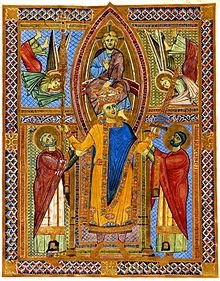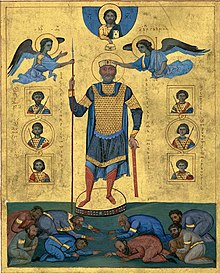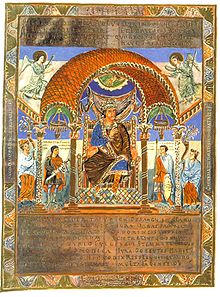Sacramentary of Henry II
The sacramentary of Heinrich II. , Also known as the Regensburg sacramentary , is a manuscript with liturgical texts produced on behalf of King Heinrich II in Regensburg , which is one of the most important works of Ottonian book art . It was donated by Heinrich the Bamberg Cathedral , was part of the cathedral treasure and came to the Bavarian State Library in Munich through secularization in 1803 , where it is kept under the signature clm 4456 to this day . The Codex Aureus of Sankt Emmeram , donated by Charles the Bald , served as a model .
description
Handwriting
Content and design
The sacramentary consists of 358 sheets of 298 × 241 mm and contains the canon of the masses , the prefations and the daily prayers .
Beginning with an elaborately designed, richly ornamented decorative page as the title page of a twelve-page liturgical calendar in gold script with the list of festivals in the church year , the manuscript with the coronation image of Heinrich contains the first figurative representation. This is followed by other well-known illustrations, the image of Heinrich's throne, which is modeled on the representation of Charles the Bald in the Codex Aureus of Sankt Emmeram, as well as a miniature with the image of Gregory the Great .
Coronation image
iconography
The so-called coronation picture is probably the most well-known picture of Henry II and the most significant and demanding picture page from the Regensburg sacramentary. It shows the king as oversized, in front of a background of four mosaic-like, diagonally corresponding in shape and color fields figure reaching the sky in the center, as he is crowned with a bowed crown by Christ himself, who blesses him and is enthroned in a golden mandorla on a rainbow . The royal clothing of the king in the form of a calf-length tunic with a belt studded with gemstones and cross-patterned applications as well as a blue pallium closed with a gold gem-studded brooch - both with splendidly ornamented patterned gold borders on the hems - emphasize the solemnity of the coronation act . Heinrich also wears dotted leg warmers and golden shoes.
Four nimbly accompanying figures assist the ruler in pairs, including two angels flying down from heaven, who hand him the holy lance and the imperial sword wrapped with ribbons with reverently covered hands . Both insignia have lost their character as weapons of war due to the jewel-studded case , but at the same time they are not recognizable as imperial regalia . The lance, which is emphasized by its positioning on the right hand of Christ, is rather characterized by its crowning with a small crucifix over a golden ball and by sprouting approaches on the shaft as a tree of life . Two bishops in pontifical robes support the ruler: St. Ulrich , identified by his hair color as the elder of the two , who was canonized as the savior of Augsburg in 993 only ten years before the manuscript was completed, takes the position of honor on the right hand of Christ, while the Finds Saint Emmeram on the left. Although the meaning of the two pillars between the ruler and the bishops has not yet been clarified, they could refer to the two pillars in the Solomonic Temple as an expression of strength and stability or as a symbol for the Old and New Testaments .
Inscriptions
The coronation image is provided with numerous inscriptions. Here are the verses around the mandorla:
+ CLEMENS XPE TUO LONGV [M] DA VIVERE XPICTO.
VT TIBI DEUOTUS N [ON] PERDAT TEMPORIS VSUS
"Gracious Christ, give your anointed one a long life,
that he, devoted to you, may not waste the use of time."
Further tituli frame the figure fields under the feet of the ruler:
+ ECCE CORONATUR DIUINITUS ATQ [UE] BEATUR |
REX PIUS HEINRICVS P [RO] AURORUM STIRPE POLOSUS. |
+ HUIUS UODALRICUS COR REGIS SIGNET ET ACTUS |
+ EMMERAMUS EI FAVEAT SOLAMINE DULCI. |
PROPULSANS CURAM SIBI CONFERIT ANGELUS HASTA [M].
APTAT ET HIC ENSE [M] CUI P [RAE] SIGNANDO TIMORE [M]
“See, God crowns and blesses
the pious King Henry, who is highly praised by the tribe of his ancestors.
May Ulrich bless the king's heart and deeds,
Emmeram may bless him with sweet consolation.
An angel brings the lance and thereby fends off anxious worry from him;
the other hands him the sword with which he will spread fear. "
classification
The fact that this miniature cannot refer to the specific event of Henry's coronation on June 7, 1002 in Mainz Cathedral is made clear by the choice of text and image. Rather, it was the illuminators' concern to portray the ruler as Christ's representative on earth. The far reaching arm gesture of the king is reminiscent of depictions of Moses fighting the Amalekites , with Aaron and Hur holding their arms until the battle was won with God's help ( Ex 17.8–16 EU ). Such a presentation within a three-figure image, which was also chosen for saints and bishops such as Ulrich von Augsburg or Sigebert von Minden , can be documented variously during this period, for example in the pontifical of Henry II. As it is in the Codex Aureus of St. Emmeram A corresponding model for the depiction of the coronation was lacking, a composition specially tailored to Henry II was developed for this purpose, which was based on Byzantine images of rulers , such as the Menologion of Basil II .
Image of the throne
The coronation image is followed by the image of Henry II's throne, framed with a meandering ribbon in perspective , on which the king is shown seated frontally on a box-shaped golden throne richly set with precious stones under the dome of a mighty ciborium , which is supported by four columns and thus probably as Image of heaven is to be interpreted. The stately garb is even more lavishly decorated with large appliqués than that in the coronation image, while the crown is bailless. In his right hand the king holds a small cross scepter and in his left hand a kreuzbekrönten orb . His head is covered by a veil over which the blessing hand of God appears.
Flanked by two youthful-looking weapon bearers in short tunics , the sword wrapped with ribbons, as well as the lance and shield, the ruler in narrow, low arcades with crowns that hang down from the crown of the vault. From the outside, two crowned women with raised horns of plenty emerge from which flowering tendrils grow: like the two three-quarter figures in the spandrels next to the canopy, they are personifications of people who bring gifts.
The green color of the faces of the figures is striking, indicating a special degree of sacredness insofar as Heinrich and the people around him are characterized as belonging to an anticipated otherworldliness.
The easily legible gold inscription in three lines above and below the image reads:
- ECCE TRIUMPHATIS TERRARUM PARTIB [US] ORBIS. INNUMERARE GENTES DOMINANTIA IUSSA GERENTES MUNERIBUS MULTIS VENERATUR CULM [EN] HONORIS. |
- TALIA NUNC GAUDE FIERI REX O BENEDICTE NAM DITIONE TUA SUNT OMNIA IURA SUBACTA H [A] EC MODO SUSCIPIAS C [A] ELI SUMPTURE CORONAS.
- “See, after the parts of the world have been defeated, innumerable peoples carry out the ruler's orders and worship the height of honor with many gifts. Rejoice, blessed king, that this is happening now, for all justice is subject to your power. Accept this now, in the future you will receive the heavenly crown. "
A very similar representation of Charles the Bald in the Codex Aureus of Saint Emmeram was the inspiration for the throne.
Gregor picture
Following the two images of the ruler, there is a miniature of St. Gregory as Pope dressed in pontifical robes and a golden maniple over the left wrist. It is located under an arcade arch in a structure designed with rows of round arches , oculi and a corner tower , which could be mistaken for a building instead of a chair . Turning to the right, Gregory, who is considered to be the author of the Sacramentarium Gregorianum, holds a quill and an eraser as a sign of his authorship of the sacramentary, whose text he notes with inspiration from the Holy Spirit , symbolized as a white dove flying down from the top right . His name inscription is hidden in the tendril stripes above the head: GREG [ORIUS] P [A] P [A]. The same theme was designed a second time by a goldsmith in a silver plate on the back cover of the binding .
cover
The front cover of the goldsmith's binding contains an ivory relief with a depiction of the crucifixion of Christ in the upper part and the women at the grave in the lower part. The highest quality work was probably created in Lorraine around 980/90, i.e. a short time before the sacramentary. The simple edging made of sheet gold goes back to a later thorough restoration and revision of the binding in Bamberg, possibly in the 18th century. The relief, framed by an acanthus frieze , is essentially mirror-symmetrical . The center is the cross with the crucified, on the head of which is the large tabula ansata with the text in capitals : IHS NAZAREN [VS] | REX IVDEORV [M] ("Jesus of Nazareth, King of the Jews"). The snake, defeated by Christ's sacrificial death, winds around the foot of the cross beam . The Golgotha hill and the grave angel follow the image axis downwards . Corresponding to both sides of the center line are the angels, Sol (sun) and Luna (moon), who appear with their heads behind bands of clouds in groups of three - they illustrate the cosmological meaning of the event - the Blessed Virgin Mary and the evangelist Johannes as well as Longinus with the lance and Stephaton with the vinegar sponge, finally the blessed who rise in pairs from sarcophagi . In the scene under the cross, the angel gestures between the empty grave monument on the left, next to which the two guards sleep, and the three women with ointment vessels approaching from the right.
On the back cover, Pope Gregory the Great is enthroned in Opus interrasile (breakthrough technique). The backed silk fabric cover, which was probably renewed later, has only survived in fragments. Gregor is shown here not as an author, but as an editor , who erases errors in the text with a razor according to the instructions of the angel. The representation has no iconographic reference to the miniature on fol. 12r of the manuscript.
The clasps of the gold-plated silver binding are on wide chain ribbons. The upper clasp is probably part of the original equipment, the lower one is a later addition.
history
The sacramentary contains numerous references to the Regensburg monastery Sankt Emmeram as the place of origin and Heinrich II as the founder. The designation of Heinrich as king (REX) is an indication of a date before the imperial coronation in 1014 . A connection with the emphatic support of the dioceses of Regensburg and Augsburg in the implementation of Heinrich's candidacy could imply the preference for Augsburg and Regensburg instead of Bamberg saints; accordingly, completion before the foundation of the Bamberg diocese in 1007 is close. Presumably intended initially for the Regensburg Cathedral , the sacramentary was first used in 1012 for the consecration of Bamberg Cathedral . Bamberg supplements on synods of 1058 and 1087 before the actual text (fol. 1v – 3v) support the special local appreciation. In the course of secularization, the manuscript finally came to Munich in 1803. The Regensburg sacramentary served as a model for other manuscripts in various parts of the empire, for example in Hildesheim and Minden .
See also
literature
- Bavaria's Church in the Middle Ages. Manuscripts and documents from the Bavarian state property. Hirmer, Munich 1960, p. 24 No. 101.
- Bayerische Staatsbibliothek (Ed.): Regensburg book painting. From early Carolingian times to the end of the Middle Ages. Exhibition catalog of the Bayerische Staatsbibliothek. Munich 1987, pp. 32-33 No. 16 and tables 5-8, pp. 94-95.
- Gude Suckale-Redlefsen: Magnificent books to adorn churches. In: Josef Kirmeier, Bernd Schneidmüller , Stefan Weinfurter , Evamaria Brockhoff (eds.): Kaiser Heinrich II. 1002-1024. Wissenschaftliche Buchgesellschaft, Darmstadt 2002, ISBN 978-3-8062-1712-4 , pp. 52-61 passim.
- Josef Kirmeier (ed.): Two Regensburg splendid manuscripts. The sacramentary of Emperor Heinrich II. The Uta Codex. (= Manuscripts from Bavarian libraries on CD-ROM ), House of Bavarian History, Augsburg 2003, ISBN 3-927233-87-0 .
- Franz-Reiner Erkens : The sacred rulers in the Middle Ages. From the beginning to the investiture dispute. Kohlhammer, Stuttgart 2006, ISBN 978-3-17-017242-5 , pp. 179-188 ( excerpts from Google Books ).
- Sacramentary of Heinrich II. Manuscript Clm 4456 of the Bayerische Staatsbibliothek, Munich. Facsimile and commentary, Facsimile-Verlag, Gütersloh / Munich 2010, ISBN 978-3-577-12908-4 .
- Werner Taegert : Treasure for eternity - Emperor Heinrich II's letter foundations for his cathedral (paragraph Heinrich II's sacramentary ). In: Norbert Jung , Wolfgang F. Reddig: Towards Heaven. 1000 years of the Bamberg Cathedral 1012–2012. Catalog of the special exhibition (= publications of the Diözesanmuseum Bamberg. Vol. 22). Michael Imhof Verlag, Petersberg 2012, ISBN 978-3-86568-754-8 , pp. 107-113 (with further literature).
Web links
- Fully digitized for the exhibition Splendor on Parchment. Treasures of book illumination from 780 to 1180 (October 19, 2012 to January 13, 2013, Kunsthalle der Hypo-Kulturstiftung Munich)
- Different version of the clm department with table of contents for navigation
- Publications on the sacramentary of Henry II in the Opac of the Regesta Imperii
- Brief descriptions of the manuscript, binding and coronation picture in the web portal of the House of Bavarian History
- Iconographic indexing of the miniatures in the Warburg Institute Iconographic Database , with links to the digital edition of the Bavarian State Library
Remarks
- ↑ Josef Kirmeier, Bernd Schneidmüller, Stefan Weinfurter, Evamaria Brockhoff (eds.): Kaiser Heinrich II. 1002-1024. P. 268.
- ↑ Josef Kirmeier, Bernd Schneidmüller, Stefan Weinfurter, Evamaria Brockhoff (eds.): Kaiser Heinrich II. 1002-1024. P. 270.
- ↑ Norbert Jung, Wolfgang F. Reddig: Towards the sky. 1000 years of the Bamberg Cathedral 1012–2012. Catalog of the special exhibition p. 109.
- ↑ Norbert Jung, Wolfgang F. Reddig: Towards the sky. 1000 years of the Bamberg Cathedral 1012–2012. Catalog of the special exhibition p. 112.
- ↑ Josef Kirmeier, Bernd Schneidmüller, Stefan Weinfurter, Evamaria Brockhoff (eds.): Kaiser Heinrich II. 1002-1024. P. 269.




